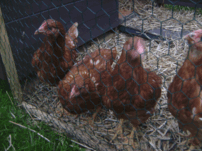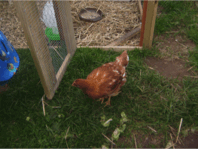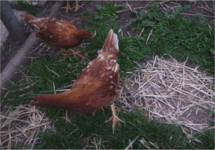Wednesday, 4 November 2009
Homeless Hens On Paul O'Grady show.
Tuesday, 2 June 2009
Would you like to rescue a hen from slaughter?
Keeping a friendly flock of hens to entertain and add life to your garden and provide a fresh supply of free-range eggs is becoming more and more common. The desire to re home battery hens is also growing in popularity. We are lucky enough to have a small plot of land for our girls to scratch around on but if your property allows it is possible to keep chickens at home. If you are keen to acquire hens that have been rescued from battery farms then continue reading for some information and advice.
Why are there Battery hens that need re homing?
There are around 19 million battery hens laying eggs in the UK. At around 74 weeks old when they are past the height of their productivity they become what are called spent hens and will go to slaughter. Commercially, hens are slaughtered, when their production drops below approximately 6 eggs a week that is required to make them commercially profitable. These carcases are worth very little and used in chicken pies, soups and some times for pet food. The farmers sometimes get a small amount of money for these but it's no longer worth their while financially to keep the hens alive.
Many spent hens are perfectly good layers for the typical smallholder or family and can be successfully re-homed.
How do I find rescued battery hens?
If you would like to give a spent hen a good home you can contact a number of organisations who organise the re homing. For example:
Battery Hen Welfare Trust. They work in co-operation with various farms across the country to rescue ex-battery hens from slaughter and provide them with good homes.
Little Hen Rescue have successfully re homed thousands of battery hens. The hens are due for slaughter unless they’re homed, sometimes because the farms are closing.
If you are considering having hens or have room for a few more, or know someone that can take them on, please get in contact one of the organisations to organise your re homing.
Is there anyone who I can ask advice?
There is a thriving community and an astounding amount of support for new and experienced hen keepers alike at www.exbatteryhens.com so once you take on your girls, you will not be alone! Just log on for information and advice.
What Accommodation do the hens need?
When choosing accommodation number of hens and space available are the key issues.
The henhouse needs to be sturdy and secure to protect from fox and badger.
When choosing a house we advise you buy one to suit more hens than you actually intend to keep. For example, if you want six hens, we would advise you buy a house to accommodate at least eight hens. This will make sure they have plenty of space not only to roost and nest, but also to take shelter from the weather during the day.
There are houses that are static with attached runs and others which are movable. You will need to assess the best option for you taking into account that hens like to peck and scratch grass - the bigger the run you can give them the better, not only for their own enjoyment, but also to keep the ground they are ranging in good condition If you decide to select a house you can move regularly and free range the hens you will need to ensure that the hens are well homed before allowing them complete freedom.
Many people choose to adapt a standard garden shed with perches and nest boxes. As a guide a 6’ x 4’ shed will comfortably accommodate 12 - 15 hens.
A number of products are commonly used on the house floor: chopped straw can be used for larger numbers of hens and shavings for small numbers. If you are using shavings it is important to buy ‘first grade’ shavings with the dust extracted. This is available from most country stores and comes in bales.
Nest boxes ideally need some soft material in order to make a cosy place in which to lay an egg. Shavings with some straw on top are a good option, although this can sometimes be a favourite hiding place of the red mite (more on bugs later).
What do I feed the hens?
Battery hens have been fed layers mash all through their life in cages. We strongly advise that at least to begin with you continue to feed layers mash or you can buy Ex-bats Crumbs, which has been specifically designed to give your hens the very best start to their free-range retirement. They can also be fed pellets, but it is important to continue the mash or crumb for a few weeks allowing the birds to get used to the change before introducing new feeds into their diet. It is advisable to feed crumb and pellets in the morning with a little mixed corn added during the afternoon. Please note treats should be fed only sparingly. Of course do not forget to have water available in a suitable container.
How strong will the hens be?
Your girls will, of course, have done nothing other than stand in a tiny cage for their entire lives. Consequently they will be very unfit to begin with and usually totally unable to jump up to a roost or nest box.
This difficulty can be overcome by placing a ramp up to the roost/nest box or giving them access to a nest box on the floor (even a cardboard box on its side with shavings and a bit of hay in will suffice until they are fit enough to use the proper facilities). It does not take them very long to build up their strength and within a couple of weeks most are capable of jumping to a standard roost height.
Will the hens be healthy?
When the hens first go into the battery cages they will have had a long list of vaccinations to protect the farmer against large losses. These are typically administered through spray misting the chicks or in the drinking water. The most common diseases vaccinated against are Marek’s disease, infectious bronchitis, salmonella, Newcastle disease, Gumboro disease and epidemic tremor.
One of the more common problems with spent battery hens is bruising, often to legs, sometimes to wings. This usually occurs when they are removed from the cages and can be so bad the hen finds it painful to stand. If you gently look you will see dark bruising under the skin and arnica cream rubbed in works wonders. As long as you see that she gets food and water, a bruised hen will recover within 7-14 days with no permanent ill effect. If possible, do not separate her from the other hens, as when you return her to the group she will be seen as an outsider and may be bullied.
Occasionally, a hen will have a broken bone and in this instance it is advisable to ask your vet to set the bone - wings and legs can be mended quite successfully.
Can the hens cope with being outside?
The hens have been used to very warm conditions within the battery unit; this is why so many have large, floppy combs (they act as heat dissipaters) - the combs will not only redden as they are exposed to the weather, but usually shrink as the hens need to drop less heat.
Understandable precautions need to be taken - if the sun is very strong the hens can suffer sunburn. Equally if it’s really cold, damp and windy, they will primarily need to be encouraged back into their new homes otherwise they tend to just stand still and get wet.
What do I do when I first get my hens?
When you first take your girls home, it’s usually best to keep them in the house for a day or so to home them. Even the pleasure of discovering a shed is far more stimulation than they are used to, so they should be quite happy. When you let them out for the first time, let them out about one hour before dusk, which will persuade them to stay near to the house and return as darkness falls.
How many eggs should I expect?
There is no guarantee of how many eggs spent battery hens will lay, generally you will get about a 40-50% production rate, for example 10 hens will lay 4-5 eggs daily.
Battery hens have absolutely no idea of a nest box facility. You will find eggs will be dropped wherever they happen to be walking. Rubber or china egg balls are a wonderful way of teaching the hens about the pleasure of laying eggs in a cosy nest. They can be quite clumsy to begin with and the rubber eggs are ideal because they are realistic and durable!
Do hens fight?
You will probably find the hens will be in total wonder of everything around them for the first few days and they will be very polite to one another. However, once they get the hang of the daily routine, usually within 2-3 days, they will then start to quarrel. You really have to let them get on with this; they are merely sorting out the pecking order. They need to know who is going to be head of the household. Try to observe that all the hens are eating and drinking and that no blood is drawn! If blood is drawn, you will probably need to separate that particular hen, as the others will only continue to bully her.
You will most likely find that it is the smallest, most feather bare hen who causes the most commotion, having at go at anybody and everybody. Please appreciate that this hen is only behaving as she is because she has probably had to fight for every mouthful of food and water within the cage and every time she’s managed to get some, someone behind her has been having a peck at her - consequently her threadbare appearance. It will sort itself out in a couple of weeks and the most troublesome hen will realise there are far more interesting things to do rather than worry about her position within her new family.
Do I need to worry about Bugs and Parasites?
The most common problem you can import when you take on battery hens is red mite. This is a tiny mite that feeds on the hens’ blood at night and then during the day lives in the shed - usually under perches or in the nesting area or simply in cracks and joins in the house.
It is something that can be controlled with many products on the market and like fleas will flare up in the warmer weather and die down during the winter months. It does not usually prove fatal to hens, though in extreme cases if left untreated can cause death.
Hopefully this has answered some of your questions, do not be too concerned about all the information as most of it is common sense and you can find lots of people to support you within whichever organisation you use to find your hens. Keeping ex-battery hens in can be so rewarding, it can have its challenges (as can any pet), but you’ll never tire of the daily egg hunt. If you are sensible, they won’t wreck your garden - in fact, they are one of the best defences against slugs and bugs. They get on fine with cats too. They’re great with kids as long as children don’t chase and poke them! When you go on holiday, if you’ve got a secure run, they’re easy for a neighbour or friend to look after.
Watching them progress from sad, pallid, scraggly, thin and slightly bemused animals to glossy-feathered, chatty, active, healthy ladies is an absolute joy. And don’t forget the fresh eggs - until you’ve cooked with your own home-produced free-range eggs, you won’t realise what wonderful benefits they have over supermarket eggs.
I hope you are keen to provide loving caring homes for some ex battery hens who desperately need some one to look after them and give them a chance. Hens are not always available so do keep looking on the organisations websites and you will eventually find your girls. Another way to acquire hens in need of homes is to contact your local school. They may have hatched hens within their classrooms. Schools sometimes hire incubators and hatch hens, but these chicks do not necessarily have homes to go to and may be slaughtered. We have had hens from local schools and although they are young and need maturing before they start laying it is still a worthwhile experience. I hope you have a great experience when you rescue battery hens.


